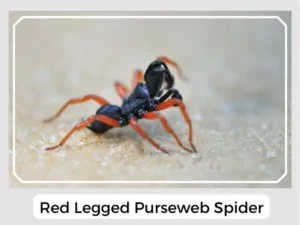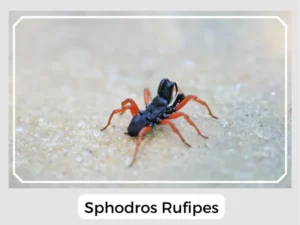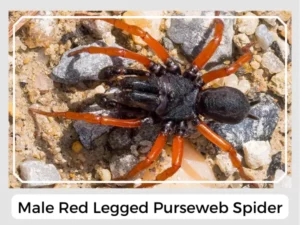Guess what? There’s a spider called the red-legged purseweb spider! It mostly lives in the southern United States, but some people have spotted it in places like Indiana and New Jersey too. Curious about this spider? We’ve got some cool facts to share, so keep reading!

Photo Credit: Vijay Somalinga
The eggs are small and oval laid in sacs.
The spiderlings replicate the adult red-legged purseweb species. Most of them have a reddish body with a black head.
They build tube-like webs near the base of the tree, 6 – 10 inches long.
Yes, Red-legged Purseweb Spiders are venomous. They use their venom to help them catch bugs to eat, but it’s not very harmful to humans.
Yes, Red-legged Purseweb Spiders can bite. They’re usually quiet spiders, but if they do bite, it feels like a tiny pinch and isn’t harmful for most people.

Photo Credit: Vijay Somalinga
These spiders play a significant ecological role as predators within their environment. Their presence in temperate forests and urban areas contributes to the control of insect populations, including caterpillars, wasps, crickets, ants, and beetles. Their hunting behavior is quite specialized; they wait within their silk tubes and attack prey that crosses over the web.
Natural Predators: The natural predators of the Red-legged Purseweb Spider include birds and parasitic wasps. These predators help to maintain a natural balance in the populations of purseweb spiders.
Prey-Predator Dynamics: The Red-legged Purseweb Spider is an active predator, using its venom to subdue a variety of insects. This predation helps to regulate the insect populations, providing a check that is vital for ecological health. Conversely, as prey, they contribute to the diet of their natural predators.
Relationship with Humans: While they are venomous, the Red-legged Purseweb Spider’s bite is typically not harmful to humans, causing little more than a minor pinch. They are generally reclusive and do not seek out human interaction. Encounters with these spiders are rare due to their elusive nature and preference for undisturbed habitats.

Photo Credit: Jim Moore
| Distribution | United States and Canada |
| Habitat | Temperate forests and urban areas, wooded lands, and grassy vegetation |
| Web Type | Tube-like |
| Diet | Caterpillars, wasps, crickets, worker ants, and beetles |
| Lifespan | Female: 7 years Male: Not recorded |
| IUCN Conservation Status | Not Listed |
In summary, the Red-legged Purseweb Spider is a noteworthy species with distinct hunting methods and significant ecological value.
Guess what? There’s a spider called the red-legged purseweb spider! It mostly lives in the southern United States, but some people have spotted it in places like Indiana and New Jersey too. Curious about this spider? We’ve got some cool facts to share, so keep reading!

Photo Credit: Vijay Somalinga
The eggs are small and oval laid in sacs.
The spiderlings replicate the adult red-legged purseweb species. Most of them have a reddish body with a black head.
They build tube-like webs near the base of the tree, 6 – 10 inches long.
Yes, Red-legged Purseweb Spiders are venomous. They use their venom to help them catch bugs to eat, but it’s not very harmful to humans.
Yes, Red-legged Purseweb Spiders can bite. They’re usually quiet spiders, but if they do bite, it feels like a tiny pinch and isn’t harmful for most people.

Photo Credit: Vijay Somalinga
These spiders play a significant ecological role as predators within their environment. Their presence in temperate forests and urban areas contributes to the control of insect populations, including caterpillars, wasps, crickets, ants, and beetles. Their hunting behavior is quite specialized; they wait within their silk tubes and attack prey that crosses over the web.
Natural Predators: The natural predators of the Red-legged Purseweb Spider include birds and parasitic wasps. These predators help to maintain a natural balance in the populations of purseweb spiders.
Prey-Predator Dynamics: The Red-legged Purseweb Spider is an active predator, using its venom to subdue a variety of insects. This predation helps to regulate the insect populations, providing a check that is vital for ecological health. Conversely, as prey, they contribute to the diet of their natural predators.
Relationship with Humans: While they are venomous, the Red-legged Purseweb Spider’s bite is typically not harmful to humans, causing little more than a minor pinch. They are generally reclusive and do not seek out human interaction. Encounters with these spiders are rare due to their elusive nature and preference for undisturbed habitats.

Photo Credit: Jim Moore
| Distribution | United States and Canada |
| Habitat | Temperate forests and urban areas, wooded lands, and grassy vegetation |
| Web Type | Tube-like |
| Diet | Caterpillars, wasps, crickets, worker ants, and beetles |
| Lifespan | Female: 7 years Male: Not recorded |
| IUCN Conservation Status | Not Listed |
In summary, the Red-legged Purseweb Spider is a noteworthy species with distinct hunting methods and significant ecological value.